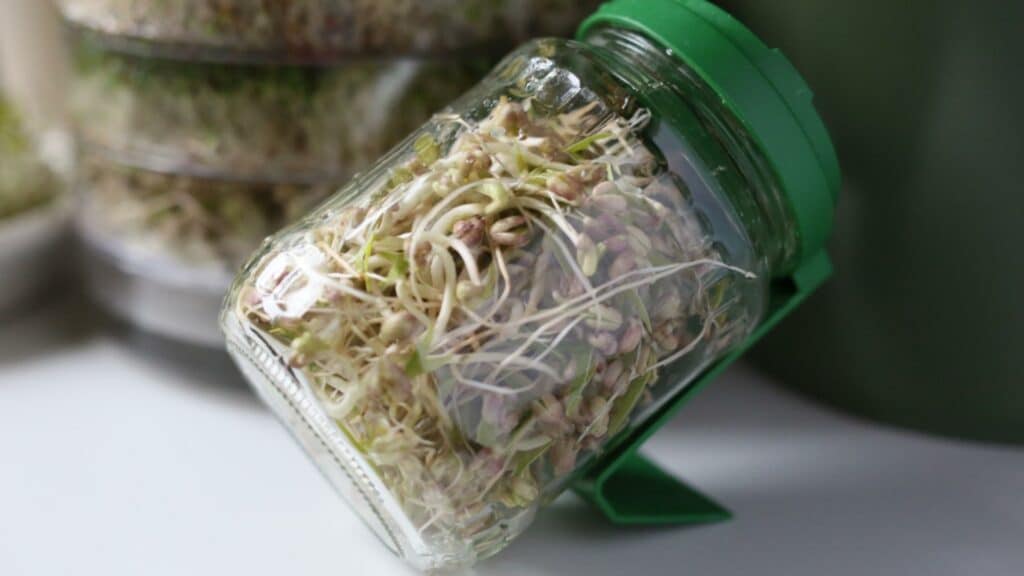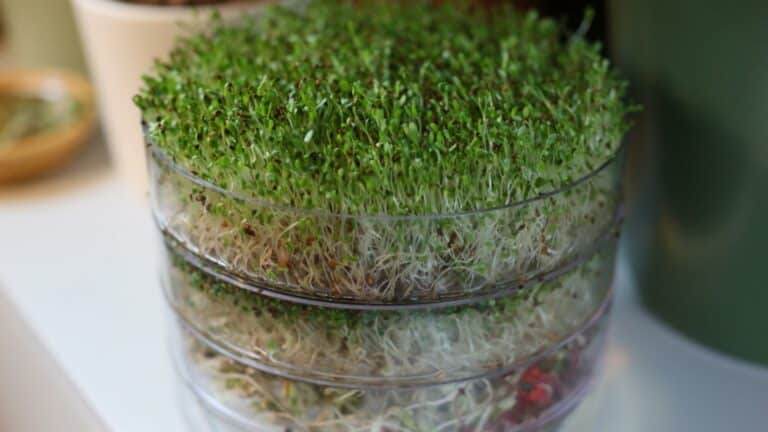In this article I describe how the seed material is germinated in a sprout tower when growing alfalfa sprouts.
For one level of the sprout tower you need 1 tablespoon of alfalfa sprouts germination material. Approximately 150 g of alfalfa sprouts grow from 1 tablespoon of seeds over the course of 7 days. The alfalfa seeds are first soaked in water in a cup or glass for 6 hours. (I do this routinely after making the celery juice, then the seeds are ready to soak at lunchtime and ready to be decanted.) The seeds are then rinsed in a sieve under running water. Then distribute the pre-swollen seeds in the top layer of the tower. Now water again with fresh water because the seeds will then spread evenly.
A bright place for growing alfalfa sprouts
The seeds are placed in a bright place to germinate; in autumn and winter, direct sunlight for 3–4 hours is not a problem. The optimal temperature for growing alfalfa sprouts is between 18°C and 22°C. In summer, when there is direct sunlight under the hood, heat builds up and the sprouts often start to mold. Therefore, please place it slightly away from the window. It is very practical if the tower stands on the windowsill in the kitchen in spring, autumn and winter, as this makes watering easier.
Water the alfalfa sprouts carefully twice a day
The sprouts are watered twice a day, in the morning and evening. To do this, approx. 200 ml of fresh water is poured onto the sprouts. Please let the water drain carefully. In the first few days, the water usually runs out without any problems through the opening under the red siphons. If it doesn’t flow at all at the beginning, tilting it slightly can help. Later, it can sometimes happen that individual sprouts push themselves directly into the opening as they grow, blocking the tiny drainage holes. This can happen from around day 3–5, but it is the exception.
In order to prevent the problem of waterlogging in such a case, from around day 3 onwards I don’t let the sprouts run in the horizontal position directly on the sprout tower, but instead take each filled bowl individually to the sink and hold it at an angle so that the water can drain away. If I place my spread hand directly on the sprouts, I can hold the bowl very slanted, even beyond a 90° angle. Here I proceed very carefully to ensure that all the water has drained away. Standing water causes waterlogging and the sprouts start to mold easily. This doesn’t happen if you drain carefully. Sometimes the extremely fine fibrous roots are confused with mold; the smell test provides information about this. Fibrous roots smell fresh and not musty. If mold has formed, for example because you forgot to water it twice, the bowl must be thoroughly brushed with hot water and a little fruit vinegar before the next use.
By the 5th or 6th day, the alfalfa sprouts have grown so tall that they want to grow over the edge. From that point on I take the lid off to give them even more room to rise. Beforehand, the lid does a good job as it creates a beneficial mini-greenhouse climate. I find it an advantage of the tower that I can easily touch the sprouts with my hand every day when watering, stroke the green heads and thus develop an even more personal connection with them. (The little plants are able to read the gardener’s information through a personal relationship with them. The sprouts read our bodies, our organs, our blood and know what is wrong and what our history is. They do everything for this , to alter their nutrients so that they are specifically tailored to our physical and mental needs). Unfortunately, this daily contact is not possible when growing alfalfa sprouts in a sprout jar.
The alfalfa sprouts are ready to harvest on the 8th day
On day 8, the sprouts are ready to harvest and can be used in a variety of ways. The seeds can be eaten whole and nothing needs to be cut off. Alfalfa tastes fresh, mild and juicy and goes perfectly in a salad (e.g. with cucumbers, peppers, onions, tomatoes, garlic and orange juice) or in a smoothie with bananas, mango or fruit of your choice. Nori rolls with alfalfa, cucumber strips and pepper strips are also very tasty. They are also a great addition to bread or as a fresh decoration on soups or other dishes. But you can also juice them very well.
Rectangular glass containers are ideal for short-term storage in the refrigerator, each with a sheet of paper towels placed in them to absorb excess water. The sprouts can be kept for 1 day.
The method of growing alfalfa sprouts in a sprout tower presented in this article is particularly suitable for larger quantities of sprouts, as the batch growing method is quite space-saving. In our two-person household, we use the sprouts from 3 sprout towers with a total of 9 layers every week from October to April. I also have 5 other sprout jars (see picture), which are also used from October to April. In total, we consume around 300 g of sprouts per day, with the vast majority ending up with me.
Alfalfa sprouts can also be grown well in a germination jar

Alfalfa is just as suitable for growing in germination jars because the seeds do not produce mucilage. This type of cultivation requires a little more space, but works just as well. You can get a large selection of all the germination devices presented here, as well as sprout seeds this page about sprout cultivation.
Give it a try, growing alfalfa sprouts is a very easy and inexpensive way to get more vibrant greenery. Plus a green that has been grown specifically for the sprout gardener and brings with it specific nutrients that are tailored precisely to the gardener. Our favorite author talks about it in his Radio show about growing your own food.
In this article about sprouts You can find even more information on the exciting topic of sprouts.
Have fun trying it out and enjoy your meal!
Author: Astrid Späth
